GUITARS, CADILLACS,
&
HILLBILLY MUSIC

Years later it seemed that everyone in the small town of Ripley, Oklahoma, had an origin myth as to how Otto Gray and His Oklahoma Cowboys came to be. After all, this was a local band that was founded on a lark only to quickly gain national prominence and fame, and everyone knew a band member—or had been a band member.
Some common elements in the many recollections are: there were a number of cowboy musicians in the Ripley area who started playing together in the early 1920s; two old-time cowboy friends—perhaps unintentionally—turned these musicians into a professional band; and a new radio station in the Ripley area spread the band’s music far and wide.
It was the Oklahoma Cowboys that between 1925 and 1936 proved that there was a demand for professional musical entertainment dressed in boots and Stetsons. Moreover, the band demonstrated that success could be had by touring, radio broadcasting, and advertising. In fact, if Otto Gray had one key for his band’s success and longevity it was: advertise, advertise, and advertise some more.
Not much of a musician himself, Gray was instead an astute businessman who knew how to combine western string band music—hillbilly music to many—with the trappings of Vaudeville, much to the delight of fans in the United States, Canada, Great Britain, and Australia.
Country music writer Tony Russell best describes the phenomenon of Otto Gray and his Oklahoma Cowboys:
For most Hillbilly bands in the 1920s, fame amounted to being known in their own community and perhaps a few surrounding counties. Thanks to radio, some became household names in several states. Celebrity on a larger scale was more elusive, but a few acts achieved it, thanks to industry and ingenuity of leaders who understood the power of promotion and the concept of a brand image. By far the most successful of these were Otto Gray’s Oklahoma Cowboys.
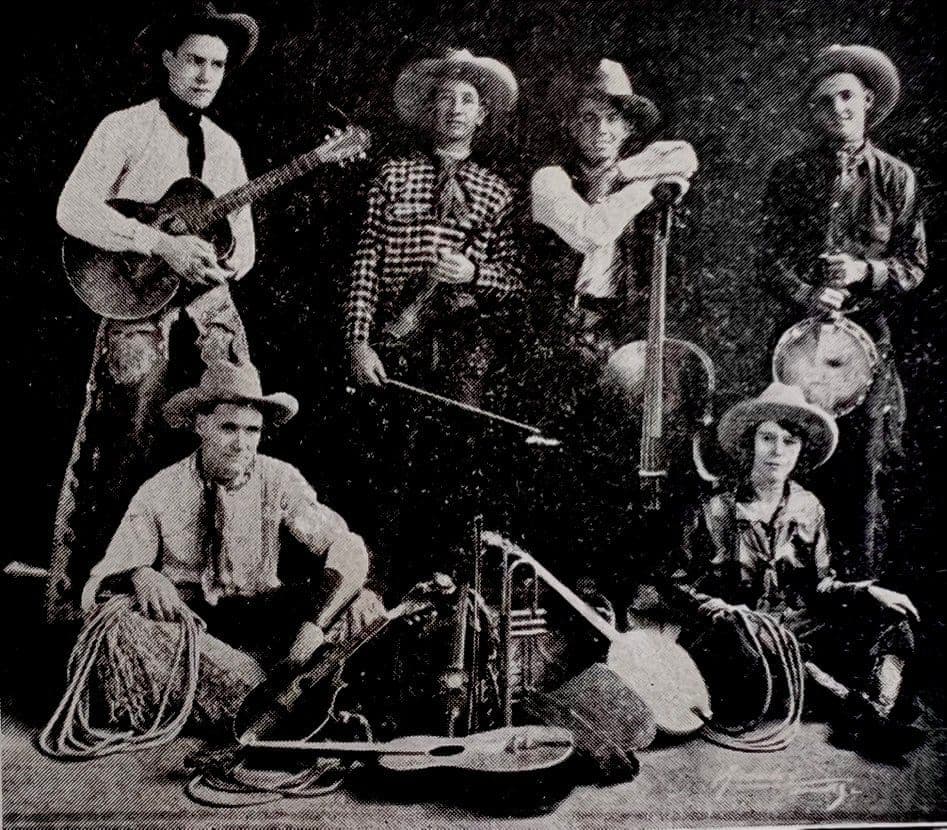
A PHOTO FROM PERHAPS 1927. OTTO GRAY SITS ON THE LEFT, HIS SON OWEN STANDS BEHIND HIM WITH HIS GUITAR, AND HIS WIFE FLORENCE SITS ON THE RIGHT. THIS IS AN EARLY INCARNATION OF OTTO GRAY and his OKLAHOMA COWBOYS.
Otto Gray and his musicians would open doors for many other country musicians with western roots.
In The Beginning …
I don’t know what we had that appealed.
Maybe it was the novelty of it.
There weren’t many cowboy bands when we started.
Otto Gray
The Oklahoma Cowboys was not Otto Gray’s band in the beginning, but that of his longtime cowboy friend Billy McGinty. One could say that either McGinty adopted the band or that the band adopted McGinty. Either way, McGinty provided the string band with it’s first name: McGinty’s Oklahoma Cowboy Band.
It was 1925. Bristol, Oklahoma, not far from Ripley, had its first radio station, KFRU—calling itself the “Etherical Company” and “The Voice of Oklahoma”—that was seeking local talent to perform on the air. From the station’s point of view there were great advantages in showcasing local talent. It was cheap, or better yet, free. Plus, it induced friends and family to tune in.
Billy McGinty’s son talked to KFRU management about allowing his cowboy string band to perform on the radio station. KFRU was receptive, but made a requirement that the band have an older, responsible person in charge. That’s how Billy McGinty became a bandleader.
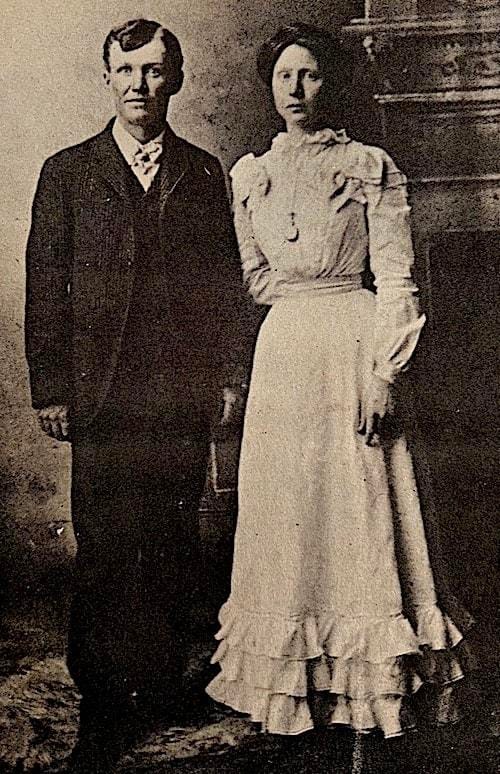
A YOUNG BILLY McGINTY WITH HIS WIFE, MOLLY.
Born in 1871, William M. McGinty was a small, wiry man who had turned his hand at many jobs, particularly those that involved horses. He cowboyed when he wasn’t bronco-busting, performed in Buffalo Bill’s Wild West shows, and dodged bullets while charging up San Juan Hill in Cuba with Teddy Roosevelt. To his chagrin he was afoot with his fellow “Rough Riders” for the latter adventure because the calvary horses had been mistakenly left behind.
Billy “was probably the greatest bronc-buster that ever lived,” a friend remembered.
McGinty was also a “character”, always ready for a new adventure. He had no problem agreeing to lead a band composed of his neighbors. That he wasn’t a musician, didn’t matter.

A YOUNG BILLY McGINTY WITH HIS WIFE, MOLLY.
Born in 1871, William M. McGinty was a small, wiry man who had turned his hand at many jobs, particularly those that involved horses. He cowboyed when he wasn’t bronco-busting, performed in Buffalo Bill’s Wild West shows, and dodged bullets while charging up San Juan Hill in Cuba with Teddy Roosevelt. To his chagrin he was afoot with his fellow “Rough Riders” for the latter adventure because the calvary horses had been mistakenly left behind.
Billy “was probably the greatest bronc-buster that ever lived,” a friend remembered.
McGinty was also a “character”, always ready for a new adventure. He had no problem agreeing to lead a band composed of his neighbors. That he wasn’t a musician, didn’t matter.
So overnight he had his own band: McGinty’s Oklahoma Cowboy Band.
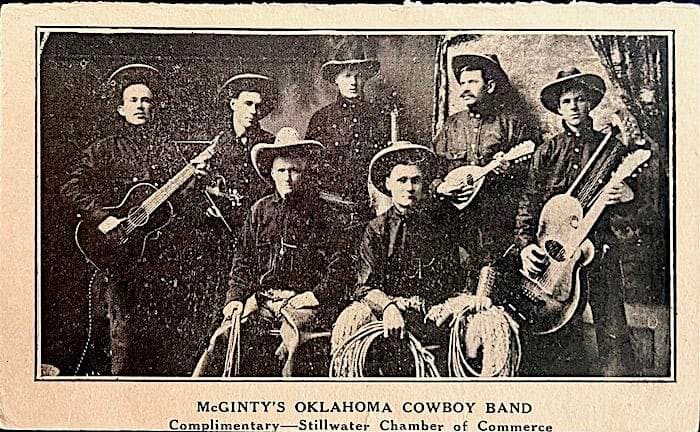
BILLY McGINTY SITS ON THE LEFT NEXT TO HIS FRIEND, OTTO GRAY, WHO WILL SOON TAKE OVER THE BAND. AT THIS POINT THE OTHER BAND MEMBERS ARE REAL COWBOYS WHO WILL LATER BE REPLACED BY PROFESSIONAL MUSICIANS. PHOTO TAKEN IN EARLY 1926.
McGinty’s decision to take on the band was no doubt based on a belief that leading a cowboy band on the radio would be a fun, but temporary diversion, and the musicians would soon go back to their cowboy day jobs. It must have been a shock to McGinty and everyone else that after the first night’s broadcast over KFRU in May, 1925, fan letters began pouring in from listeners throughout Oklahoma and Kansas. The public wanted to hear more of the Oklahoma Cowboys.
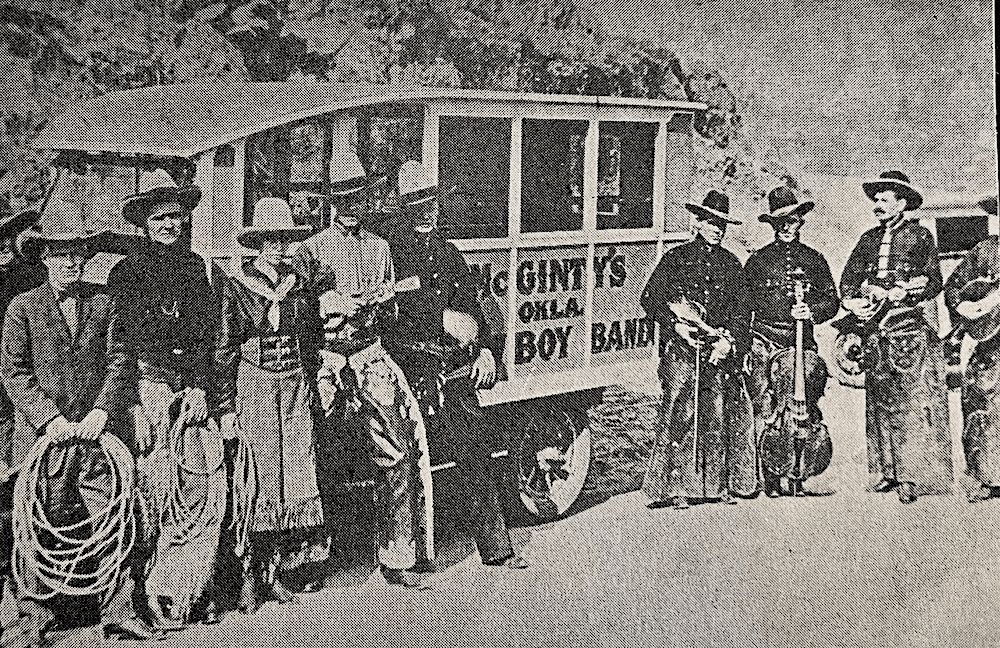
BILLY McGINTY STANDS ON THE LEFT NEXT TO HIS FRIEND, OTTO GRAY, WHO WILL SOON TAKE OVER THE BAND. AT THIS POINT THE MOST OF THE OTHER BAND MEMBERS ARE REAL COWBOYS WHO WILL LATER BE REPLACED BY PROFESSIONAL MUSICIANS. PHOTO TAKEN IN EARLY 1926.
Quickly enough McGinty realized that he was in over his head. He was neither a musician nor a businessman. Now, offers to tour were coming in with the myriad fan letters. Plus other radio stations expressed an interest in his band. Looking around for help, an overwhelmed McGinty turned to his friend Otto Gray. If Gray would take over the band, McGinty reasoned, then Billy could take the job he really wanted: postmaster of Ripley.
Otto Gray
I believe what kept us at the top in the end
was we were authentic.
Otto Gray
Whether by accident or design Billy McGinty started the world’s first modern cowboy band. It was Otto Gray, however, who would make it successful. He took over full management of the band in January, 1926.
Otto Gray was born in 1884 in the Dakota Territory. He and Billy McGinty had been friends for years, and the two shared much in common. Although fourteen years younger than his friend, Otto, too, had spent much of his life on horseback, growing up in a ranching family. Like Billy he had found himself attracted to show business early on, performing as a trick roper at rodeos and other events.
By 1918, Gray and his family moved from their ranch into nearby Stillwater, Oklahoma, first to sell real estate and later to operate a furniture store. Gray was a first-rate rancher, and although he only had an eighth grade education he was also an astute businessman.
Membership in the Oklahoma Cowboys quickly turned into a full-time job for everyone, and touring started taking the band beyond the Oklahoma borders. As members dropped out to return to their ranching jobs Gray replaced them with professional musicians.
Soon the marquee would read:

In time it would read:

It was working the rodeo circuits, performing roping tricks as a young man, that Gray met his future wife, Florence Powell, another trick rope performer. They married in 1906, settled down to ranching life, and had one child, Owen.
Otto and Florence probably had no expectation that they were beginning a show business career when they got the call from McGinty. Neither did they realize that they, along with their eighteen-year-old son, would soon turn the Oklahoma Cowboys into a family business that blended the traditions of Vaudeville with cowboy trappings and distinctively western music. But it happened, and the Gray family would stay on the entertainment road almost constantly.from 1926 through 1936.
Gray set up the Oklahoma Cowboys’ base of operations in Stillwater, Oklahoma. Then he took the band on tours of the Midwest and later the northeast United States, year after year. In time, the band would gain fans both nationally and internationally.
RADIO
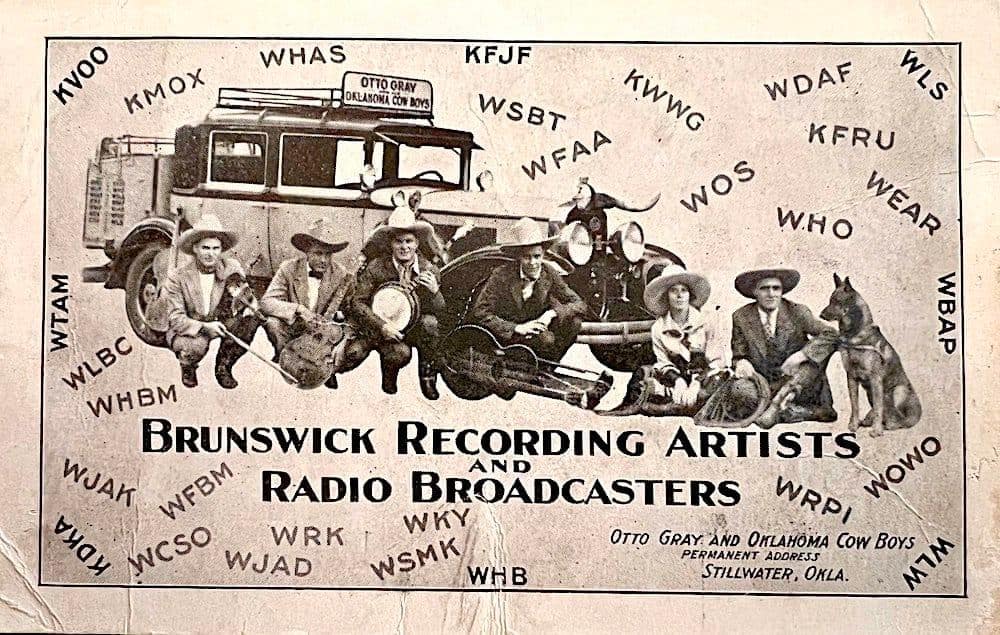
“Radio Broadcasters”
“Direct From Radioland”
“A Record Breaking Radio Stage Attraction”
“On the Air Everywhere”
“Famous NBC Radio Stars”
On advertising posters and postcards Otto Gray and His Oklahoma Cowboys often highlighted its radio success by scattering radio call letters throughout the artwork, an example of which can be seen in the above postcard.
Gray was the first cowboy band leader to realize the magic of radio in promoting what the recording industry was beginning to call “Old Time Music”, an amalgamation of folk, hillbilly, country, cowboy, and western music, usually played on stringed instruments.
It was a little country radio station in Ripley, Oklahoma, that started Otto Gray and his Oklahoma Cowboys on the entertainment trail to national recognition and success; by the time the band played its last engagement in 1936, it had broadcast from 150 radio stations, big and small, around the country.
Otto Gray and his Oklahoma Cowboys was not just a group of cowboy entertainers. From the beginning its members proudly identified themselves as “radio broadcasting artists”.
Every time that the Oklahoma Cowboys were in a new town performing for free on a local radio station, the band was given a great opportunity to plug its upcoming stage shows. Thus Gray quickly learned that when he secured a stage booking, the next step was to contact the local radio station. And from the stage the band plugged its radio shows. Thus the ball kept rolling and rolling, and the fan base kept expanding.
When the Oklahoma Cowboys did a series of short roadshows, playing in small communities along the way, it advertised its shows by performing for free at the local radio stations. However, as the band’s popularity increased it often made extended visits in cities, and there the band would be hired to do its own radio shows for a period of time. This occurred in Chicago on WLS, in Schenectady on WGY, and in Tulsa on KVOO.

THE BROADCAST STUDIO AT WLS IN CHICAGO AT THE TIME THE OKLAHOMA COWBOYS WERE DOING A DAILY SHOW.
KVOO, it turned out, was the old KFRU. After McGinty’s Oklahoma Cowboy Band got its start there, the radio station changed its call letters, then pulled up stakes and moved from Bristol to Tulsa.

THE OKLAHOMA COWBOYS BROADCASTING FROM THE STUDIO OF WGY IN SCHENECTADY, NEW YORK.
There is no documentation that Otto Gray and his Oklahoma Cowboys ever performed in Canada, but it performed in American cities close to the border. Certainly by the 1930s the band’s radio broadcasts were being heard, not only nationally, but in parts of Canada. This would explain why the band’s recordings for Melotone in 1931 were issued under both the company’s American and Canadian labels.
THE REPERTOIRE
&
THE RECORDINGS
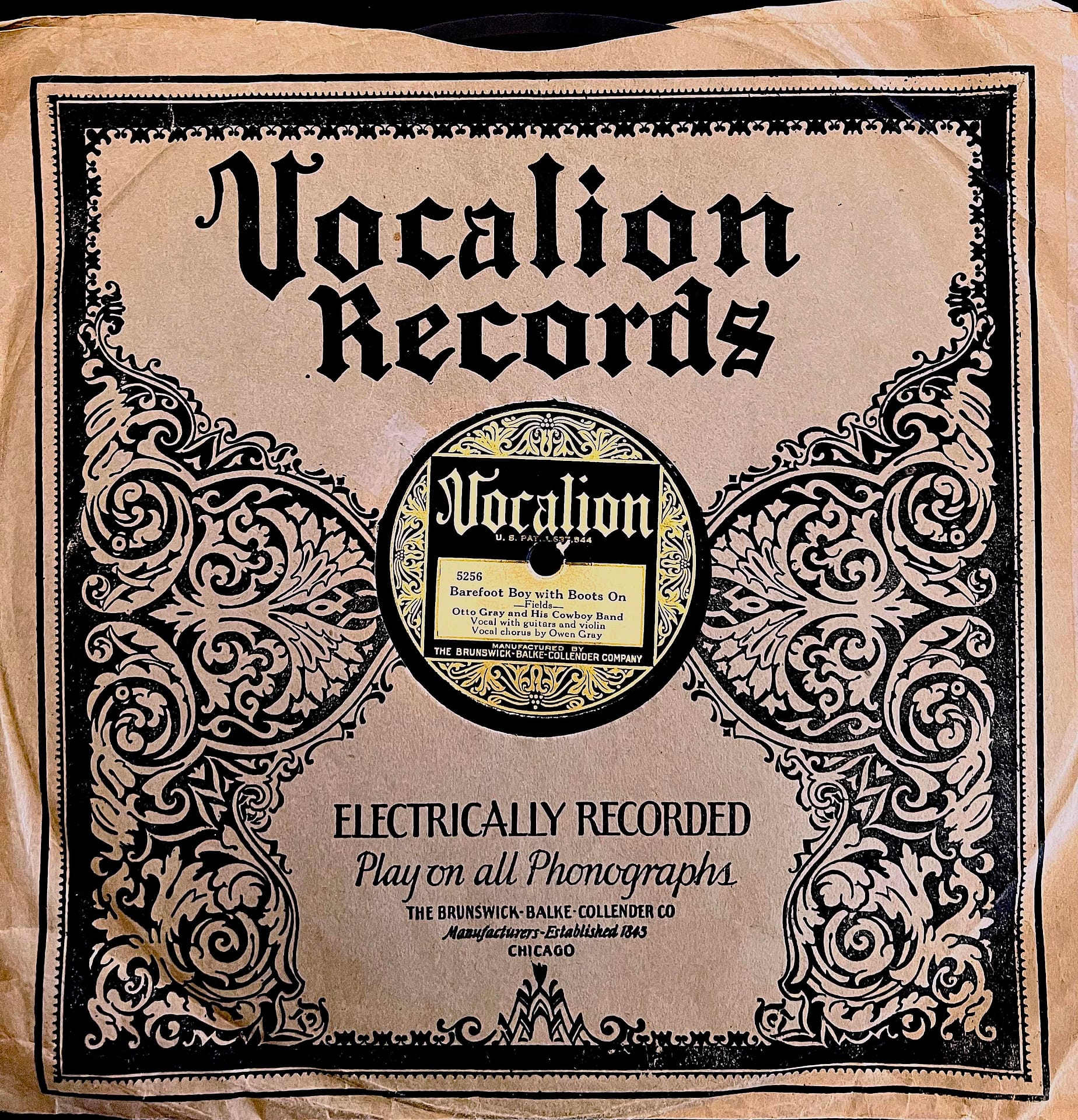
Hello Folks!…………………………………………
We all hope you will get as much fun and
enjoyment out of singing these songs as we do.
Sincerely,
OTTO GRAY
From an Oklahoma Cowboys’ songbook
From the beginning of the band Otto Gray promoted its songs and music in two tangible forms: songbooks and 78 rpm records.
What had sufficed for a “cowboy band” in earlier times usually consisted of a couple of fiddlers and a guitarist playing for dancers on a Saturday night. No singing, just music. This was not Otto Gray and his Oklahoma Cowboys. Gray’s was not a dance band. The only dancing done at its shows was performed by Otto and Florence on stage. Rather, it existed to entertain the public through music, singing, skits, humor, and, of course, rope tricks. “Sit back, listen, and enjoy.”
The Oklahoma Cowboys usually consisted of six or seven members. Otto directed the show and handled the announcing. He performed rope tricks with his wife who was known to the audience as “Mommie”. She sang the sad, maudlin songs. Son Owen played multiple instruments and sang the humorous songs.
The other band members were hired professionals who rotated through the line-up, often staying a year or two. They all played multiple instruments, could assist in the skits, and one or more usually had a good singing voice for handling the popular songs, those not reserved for Florence and Owen.
A review of their songbooks and records indicates that the Oklahoma Cowboys’ repertoire was divided into three categories: traditional cowboy songs that Otto would have heard in his early days of working cattle; maudlin songs aimed at women that had been published as piano sheet music ten to twenty years earlier; and humorous songs that were performed on Vaudeville stages and in traveling tent shows, i.e., Tin Pan Alley songs. The Oklahoma Cowboys cast a wide net for its musical material. Some songs were no doubt learned from of 78 records.
Below is one of the band’s earliest songbooks dating from a time—probably 1926—when it was still using the McGinty name.
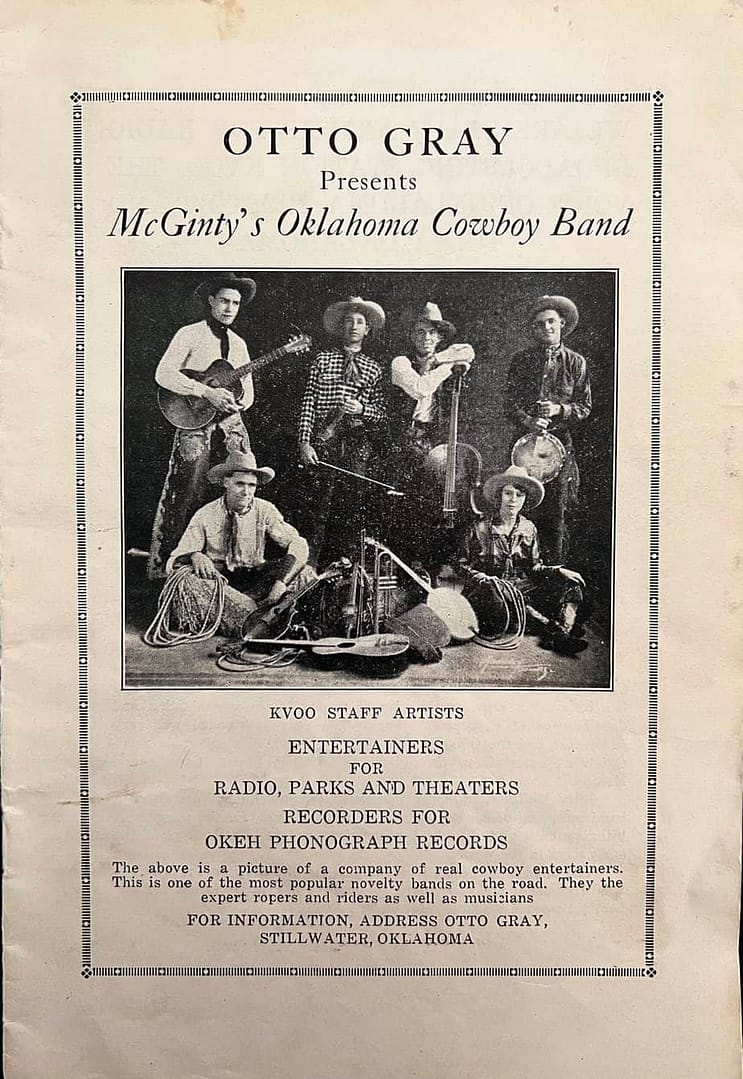
Otto Gray officially switched the name of the band in late 1927 or early 1928. The next songbook, below, reflects the new name: “Otto Gray and his Oklahoma Cowboys”. Both songbooks were sold at shows. No price is shown for the first one, but the second indicates that extra copies can be purchased through the mail for fifty cents a piece—a significant sum in the 1920s and early 1930s, especially during the Great Depression years.

In the 1920s and 1930s recording royalties were such that few recording artists could live off of 78 sale earnings, unless you were Jimmie Rodgers or the Carter Family, and even those artists regularly performed on stage to supplement their record income. Many performers saw making records as a sideline that could be used as advertising for their stage shows where they made their real money. Thus, it would have been for Otto Gray and his Oklahoma Cowboys.
Unless a 78 record proved to be a bestseller, when it sold out it was not re-pressed and in time became unavailable. None of the Oklahoma Cowboy recordings were bestsellers. Therefore, even though the Oklahoma Cowboys had twenty-nine of its songs issued, there were times when none of its 78s were available in stores.
Being the savvy businessman that he was, Otto Gray may have stockpiled boxes of band records bought directly from the record companies at a performer’s discount. Along with the songbooks, these records could be sold at shows—another way to advertise, as well as earn a little extra spending money.
Between 1926 and 1931 the McGinty/Gray band recorded for Okeh (McGinty), Gennett, Vocalion, and Melotone, its music being issued under these labels, as well as under subsidiary labels, including Champion, Silvertone, Supertone, and Panachord (British).
In time, Oklahoma Coyboys’ 78s could be found in record shops in the United States, Great Britain, Canada, and Australia.
Below are some of the record labels and songs recorded:
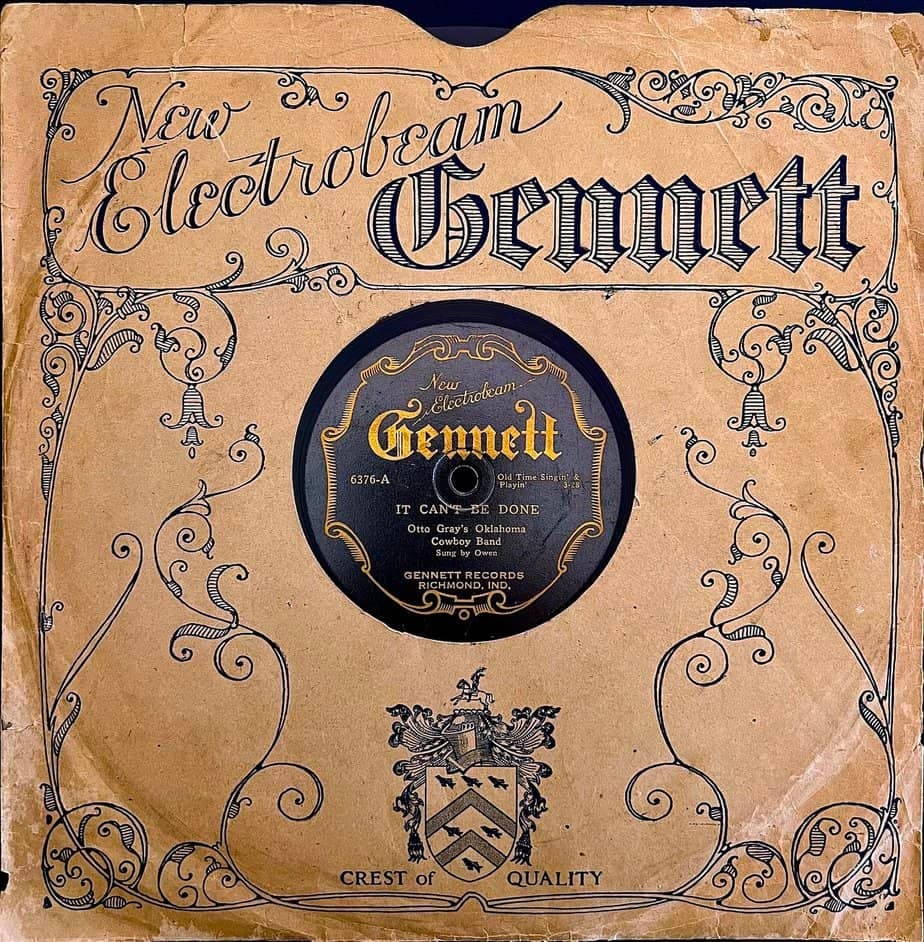
“IT CAN’T BE DONE” FROM 1926 GENNETT SESSION UNDER THE NAME OTTO GRAY’S OKLAHOMA COWBOY BAND.

THE FLIP SIDE OF THE ABOVE RECORD, “ADAM AND EVE” WAS ONE OF THE OKLAHOMA COWBOYS’ MOST POPULAR SONGS, LATER BEING RECORDED A SECOND TIME FOR VOCALION RECORDS
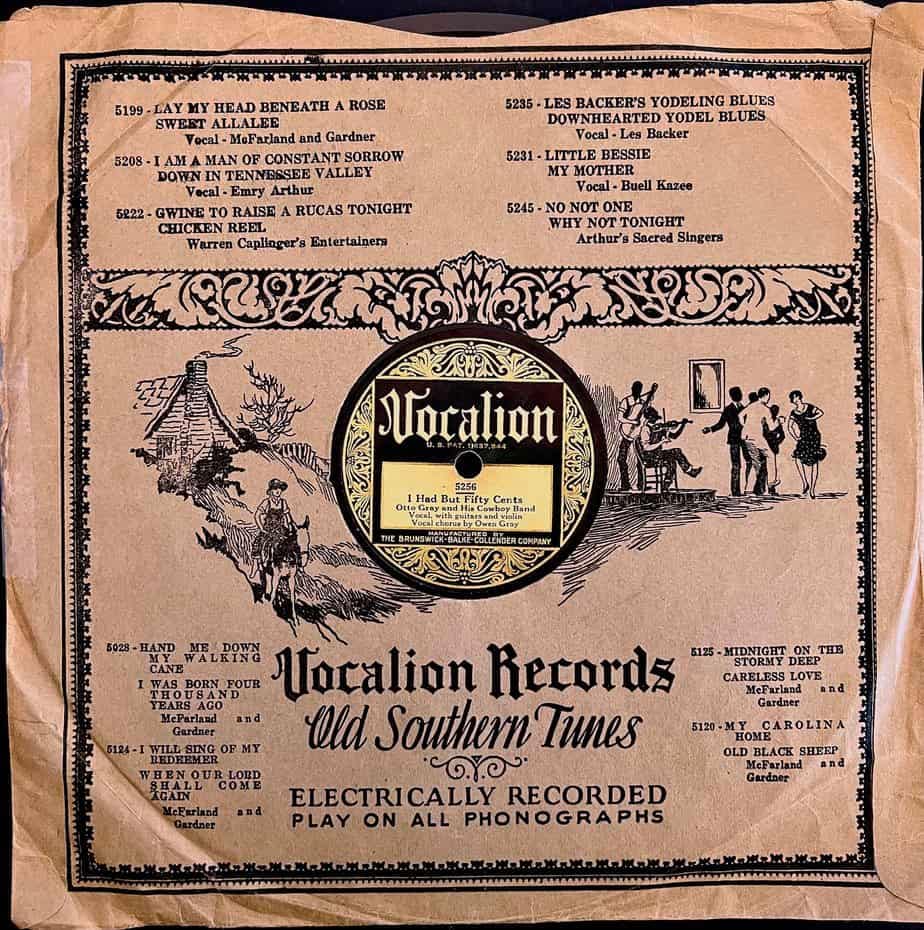
“I HAD BUT FIFTY CENTS” STARTED LIFE AS A HUMOUROUS POEM IN THE LATE 1800s, WITH NUMEROUS COUNTRY ARTISTS RECORDING IT. THE OKLAHOMA COWBOYS RECORDED IT FOR VOCALION IN 1928, WITH OWEN GRAY SINGING.

“YOUR MOTHER STILL PRAYS FOR YOU” WAS RECORDED FOR GENNETT IN 1928, AND ONLY ISSUED ON SUPERTONE, A RECORD SOLD EXCLUSIVELY BY SEARS, ROEBUCK, AND CO. “GRACE MEANS” IS A PSEUDONYM FOR FLORENCE GRAY.
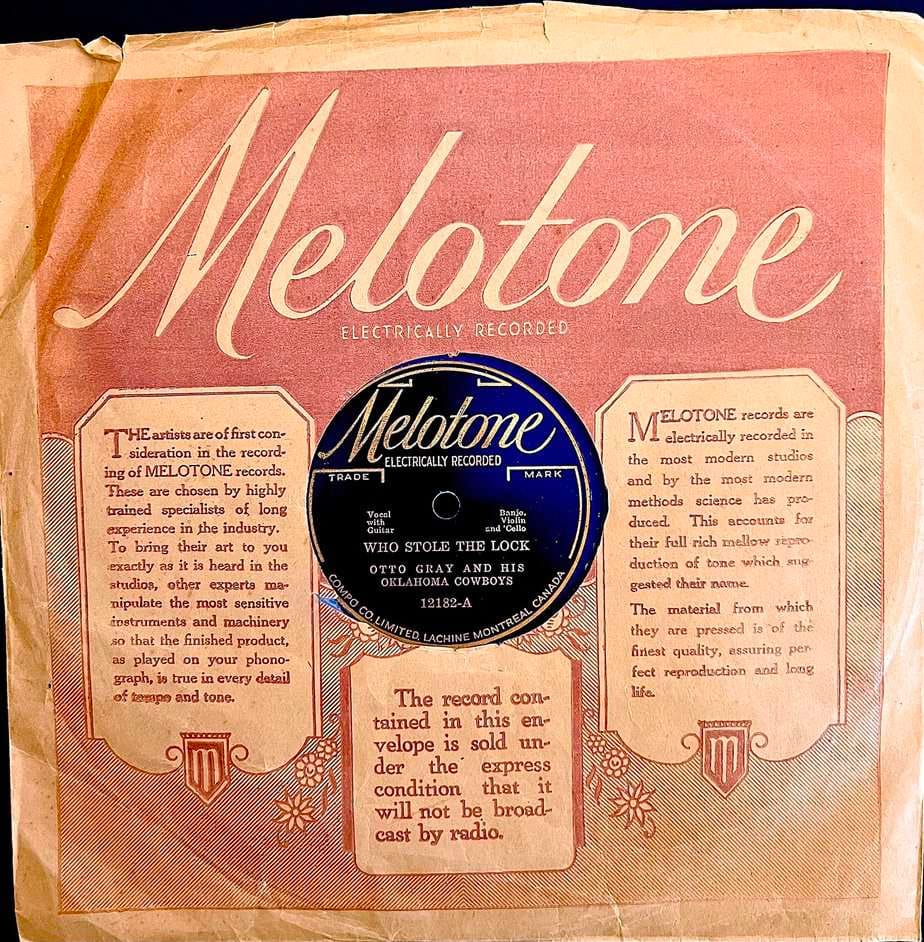
THE MELOTONE RECORD COMPANY WAS STARTED IN 1930 AS A SUBSIDIARY OF THE BRUNSWICK RECORD COMPANY TO MARKET A CHEAPER “DIME STORE” LABELS DURING THE GREAT DEPRESSION. BRUNSWICK HAD BEEN THE PARENT LABEL FOR VOCALION, THE RECORD COMPANY THE OKLAHOMA COWBOYS HAD RECORDED FOR PREVIOUSLY. MELOTONE MARKETED ITS RECORDS BOTH IN THE UNITED STATES AND CANADA. THE ABOVE 78 IS ON ITS CANADIAN LABEL.
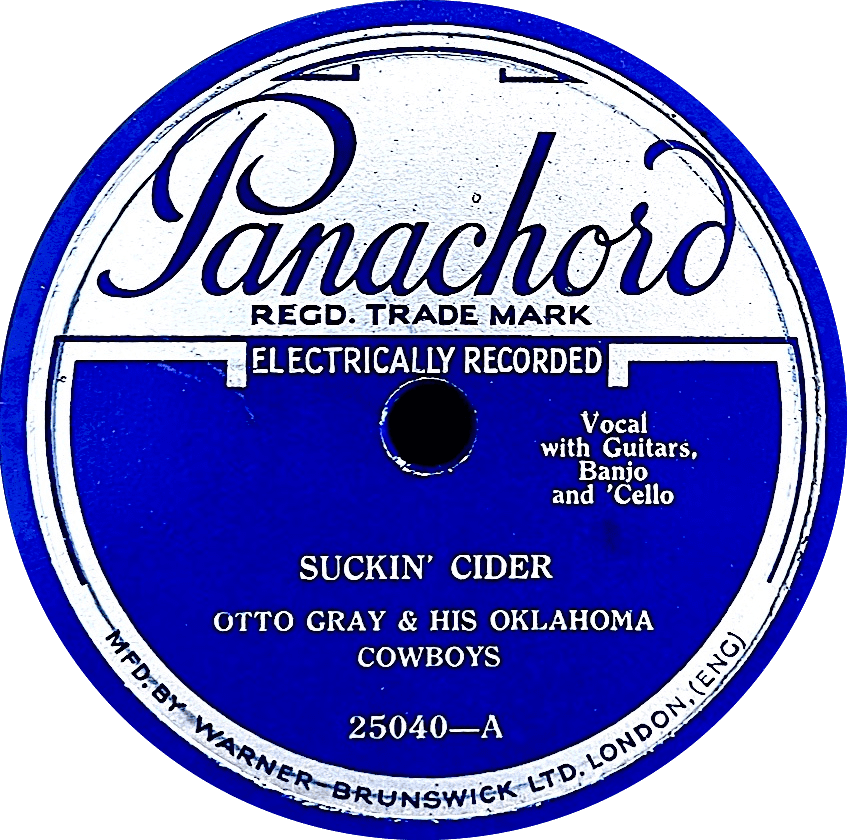
SOME OF THE MELOTONE RECORDINGS FROM THE OKLAHOMA COWBOYS’ 1931 SESSION WERE ALSO RELEASED ON THE BRITISH PANACHORD LABEL.
ON THE ROAD
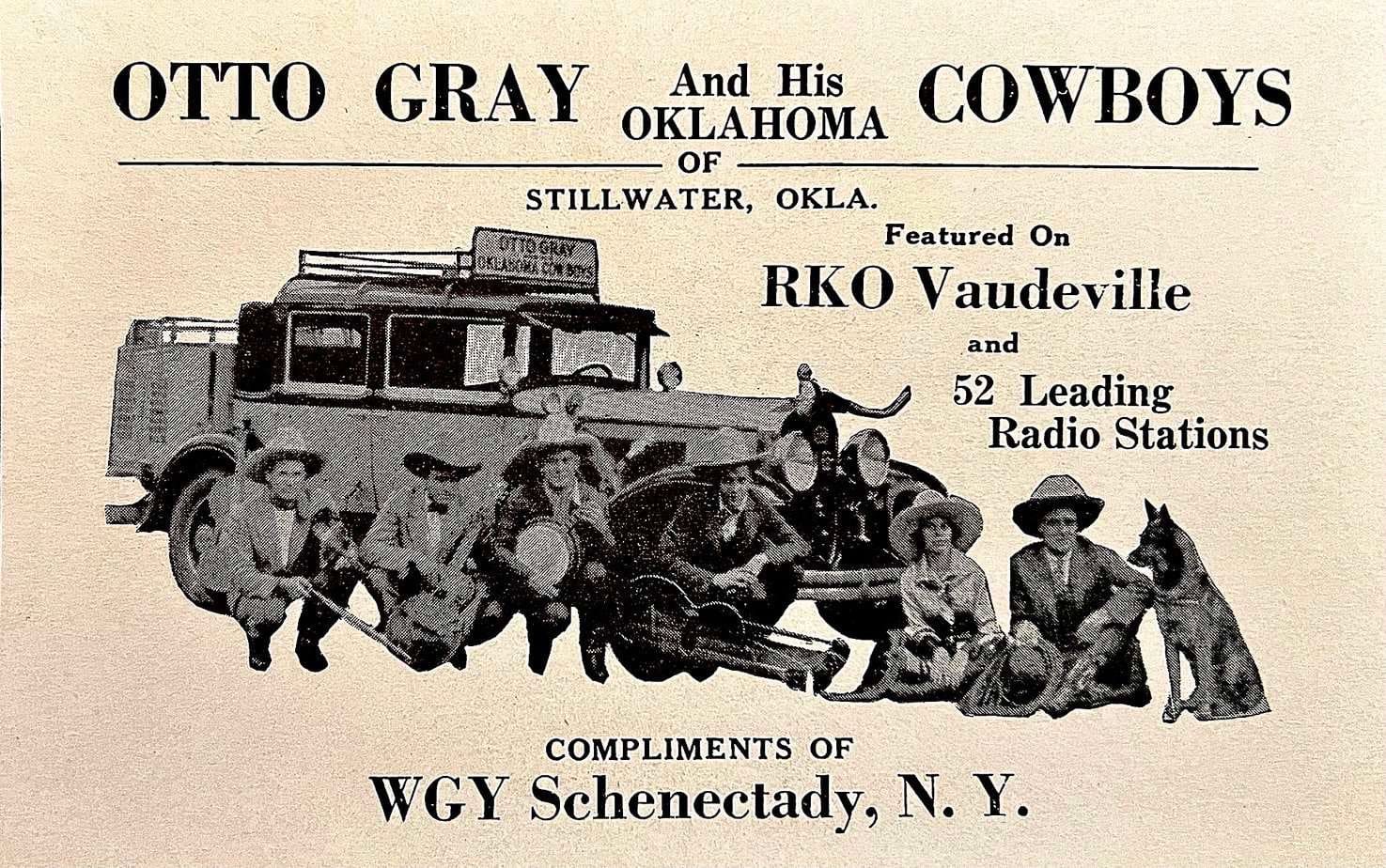
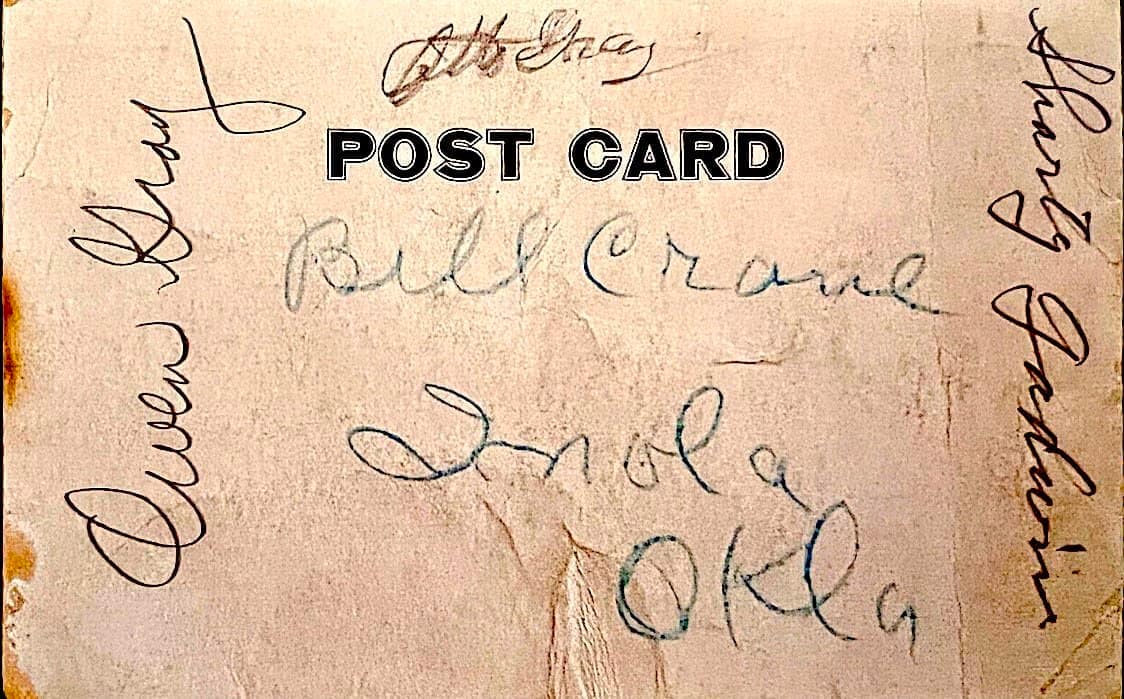
As soon as Otto Gray began managing Billy McGinty’s band he got the group out of Oklahoma and on the road, playing on the Orpheum theater circuit in Missouri. The touring was more than the cowboy musicians bargained for and most soon drifted back to their Oklahoma ranches. The pragmatic Gray quickly replaced them with professional musicians. For the next ten years the band would stay on the road almost constantly.
Apparently the Oklahoma Cowboys did some touring in the Southwest and upper South, but their bread-and-butter tours were initially those of the Midwest and later the Northeast, working the prestigious RKO theater circuit. The sounds of cowboy and hillbilly bands were not unique in the South and Southwest, but elsewhere the Oklahoma Cowboys were a novel enterprise.
Touring north of the Mason-Dixon Line turned the Oklahoma Cowboys into an exciting musical act in Stetsons and cowboy boots, something you didn’t see every day. This was not just cowboy-themed music, but also banjos, guitars, and fiddles, plus rustic humor, roping, cowboy attire, and “Rex, the Radio Dog”. The Grays, of course, were a real cowboy family, and they came across as such to their fans.
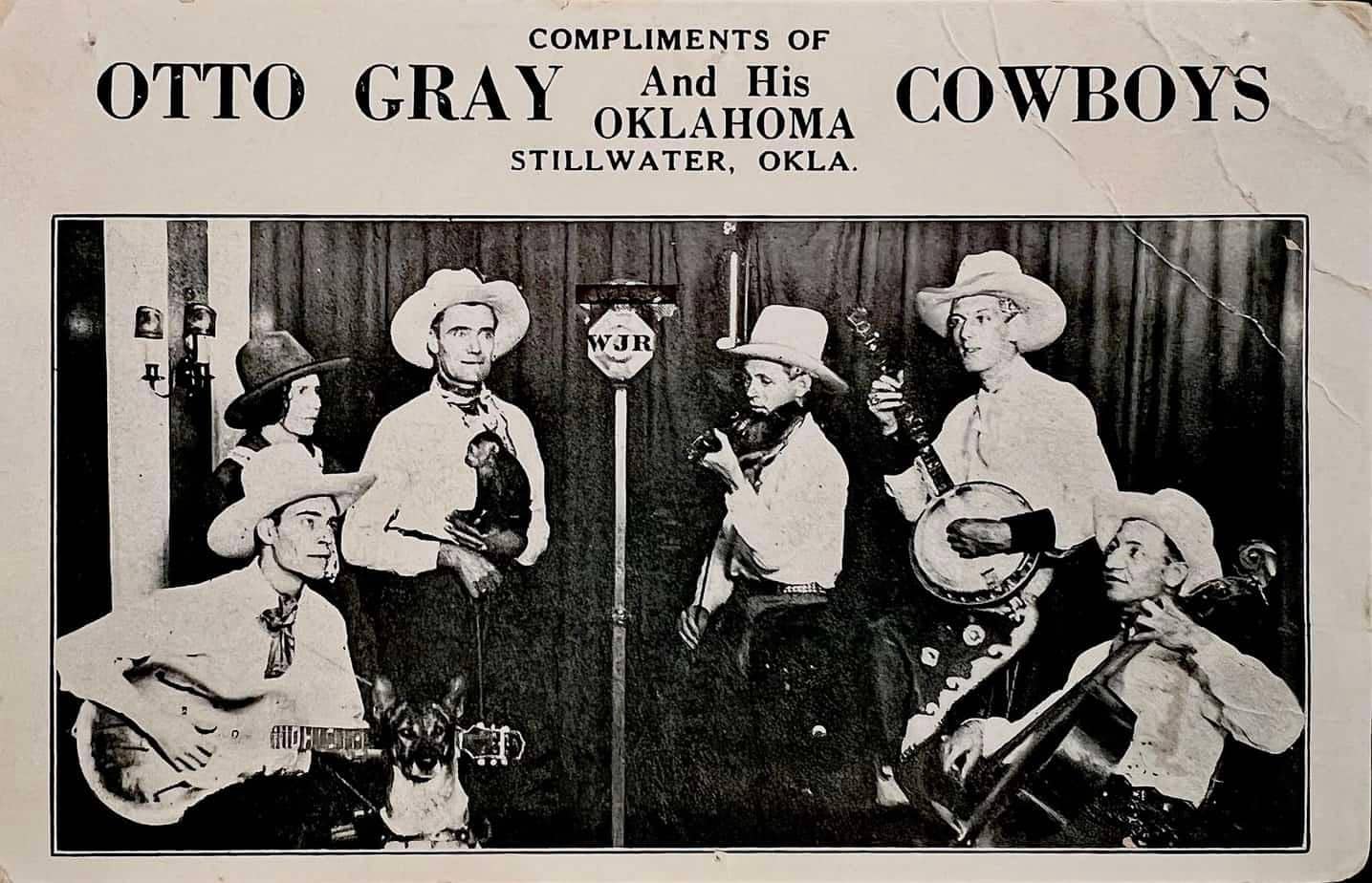
OTTO GRAY HAD A LIFELONG AFFINITY FOR ANIMALS AND COULDN’T RESIST ADDING THEM TO THE SHOW. “REX THE WONDER DOG” IS IN THE BOTTOM LEFT CORNER OF THE POSTCARD. REX FOLLOWED THE BAND’S FIRST DOG, “DUKE”. PLUS, IF YOU THINK A MONKEY HAS BEEN ADDED TO THE BAND YOU’RE RIGHT. CRADLED IN OTTO’S ARMS IS “CHIP” WHO WOULD BE TURNED LOOSE DURING PERFORMANCES TO SCAMPER ABOUT THE STAGE. SOMETIMES CHIP WOULD RIDE A PONY.
In 1930, for the first time, the Oklahoma Cowboys’ caravan of touring cars and trailers traveled to the Northeast, playing venues from Philadelphia through New York State.
Ten years of constant touring is rough at any time, but in the 1920s and 1930s, bad roads, poor accommodations, and the lack of amenities made such a life particularly stressful. To compensate, Otto Gray ensured that his troupe traveled in style.
Early on Gray purchased a fleet of Cadillac touring cars. In those days, Cadillacs were bought, not only for luxury, but also for safety. One of the heaviest cars, a Cadillac could hold up to the poor roads of the day, and was less likely to skid and roll. In Oklahoma in 1925, when the Oklahoma Cowboys started traveling, out of 5156 miles of State roads, only 374 were paved. Others were graveled, but most were simply “graded”—a fancy name for dirt.
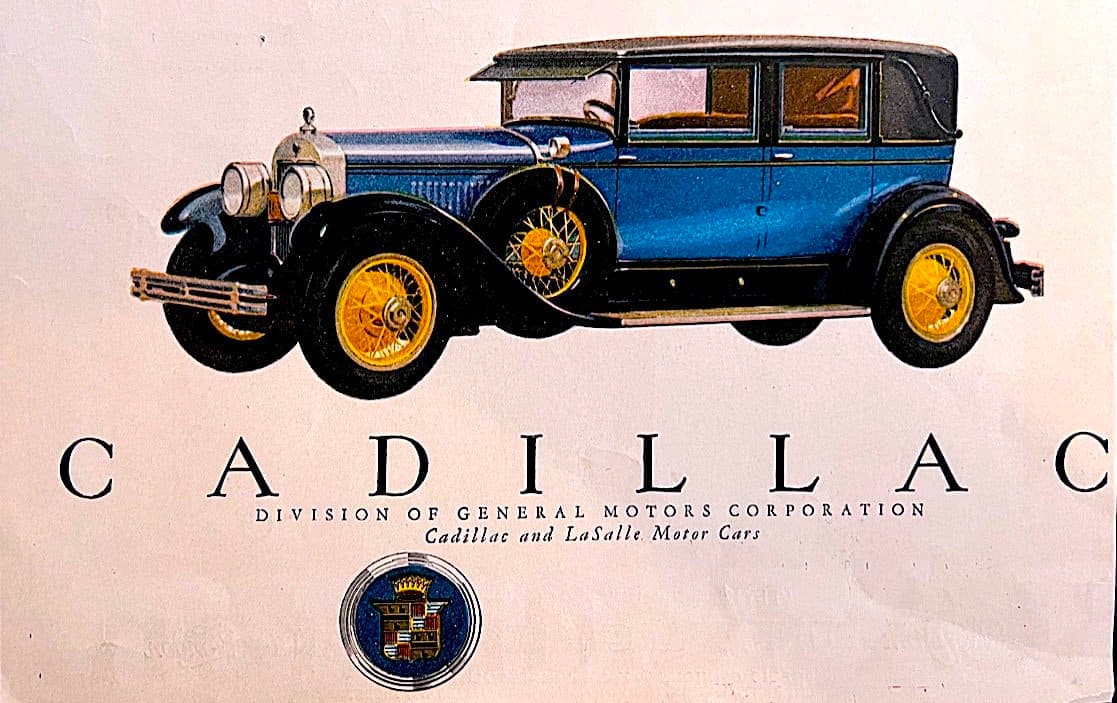
The Cadillacs were both comfortable and practical. Moreover, they served as advertising for the band. Bedecked with Texas-sized cow horns on the grills, they were also wired with loud speakers, and had “Oklahoma Cowboys” either painted on the sides or as a sign on the car roof.
In addition, the cars towed trailers for both music and equipment, as well as for sleeping accommodations. Usually the band travelled with everything needed for its stage shows. Its only requirement of theater management was to provide bales of hay. Like a traveling circus, this was a self-contained, cross-country entertainment caravan, introducing homespun music and humor to new audiences across the land..

ON STAGE
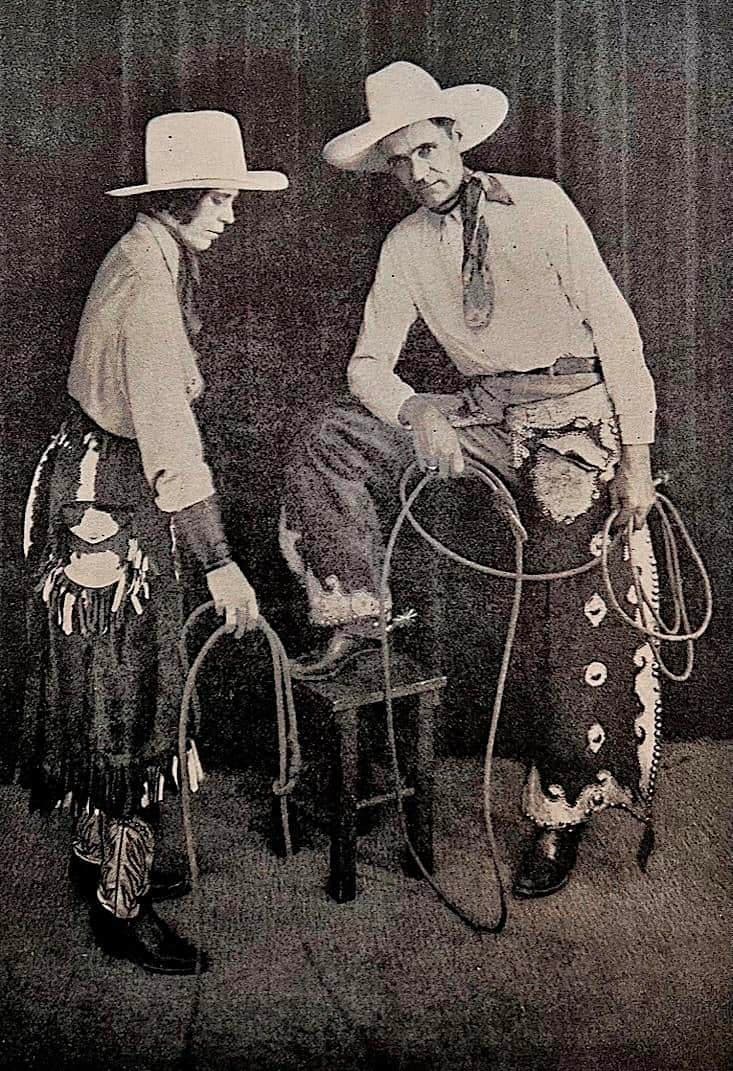
By the time McGinty’s Oklahoma Cowboy Band ventured out of the safe confines of the Oklahoma borders into the the world of the Vaudeville circuit in Missouri, the writing was already on the wall that this was not a life for amateurs. The band would give the illusion of rusticity and life on the range, but to survive it would have to become a professional act, one that was run as a business, albeit a family business. Otto Gray would see to that.
Otto Gray and his Oklahoma Cowboys was a self-contained traveling show that played many of the top theaters of the day. It strove to give attendees what they wanted: music, laughter, and variety, including roping tricks and a performing dog. And when the show was over Otto Gray sold 78 records and music books to a well-satisfied audience.
Generally, members of the band played all necessary roles and were the show’s entertainment. From time to time, however, other traveling acts would be incorporated into the show. At one time, Gray added a knife-throwing act. If it entertained the audience then Gray was game.
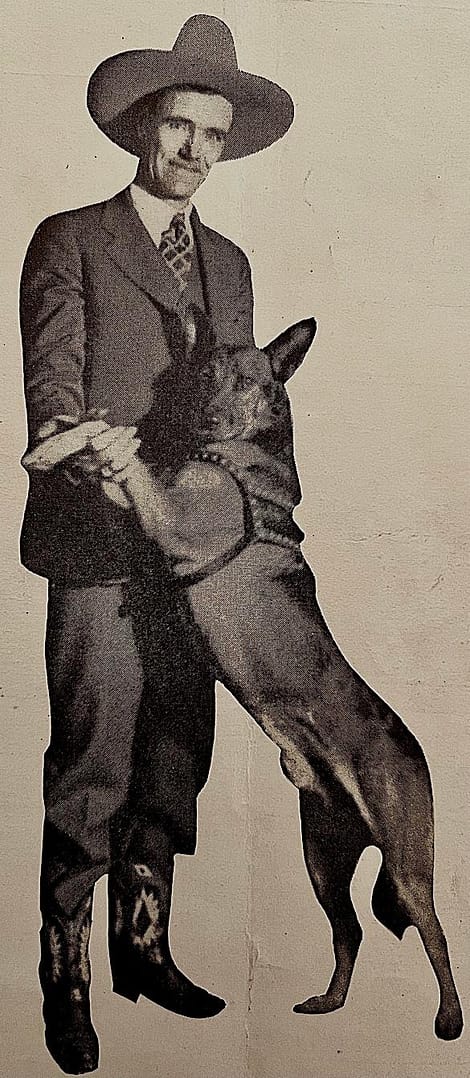
Most of what we know about Otto Gray and his Oklahoma Cowboys on stage we glean from old newspaper articles. Luckily, however, there exists one “movie short”, a 14-minute filming of parts of the performers’ various stage acts. It appears to have been filmed in a studio, rather than live on stage, and was released by “Veribest Pictures” out of New York in 1930.
This is as close as we can now get to an Oklahoma Cowboys stage show:
THE LEGACY
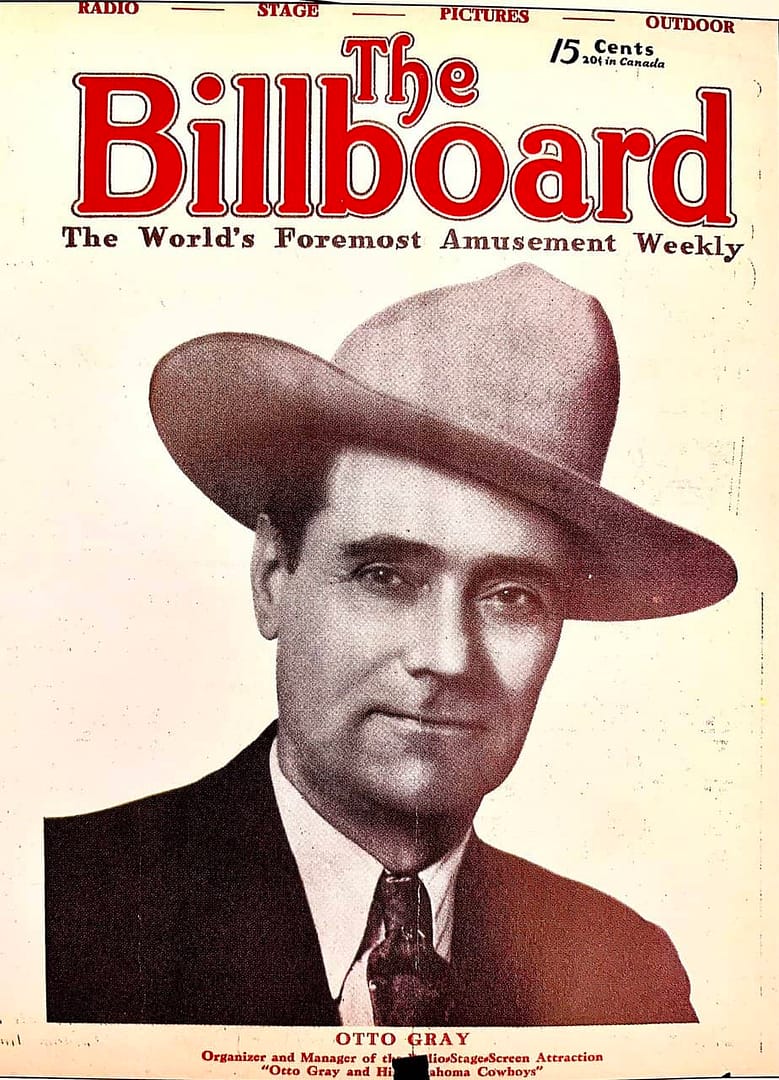
Otto Gray and his musicians made the cover of Billboard Magazine—the trade publication of the entertainment industry—two times, a sure sign that they had hit the big time. They had. Yet time, ultimately has not treated the Oklahoma Cowboys kindly. Because today they are forgotten.
In the 1920s and 1930s the band’s musicians were entertainment pioneers successfully promoting their brand of cowboy music, both live on stage and over radio throughout the country.
When recording hopefuls Jimmie Rodgers and the Carter Family were auditioning for Victor Records in Bristol, Tennessee in 1927, at what is now considered the “Big Bang” of country music, Otto Gray and his Oklahoma Cowboys had already emerged as a major attraction on the Vaudeville circuits and had saturated the country with radio performances. They had already recorded their first records in 1926.

Today, however, the band and its musicians are lost memories, even among 78 record collectors who specialize in “Old Time Music”. A significant reason for this can be found in the 78 recordings of the Oklahoma Cowboys.
All we have left today to help us understand the band’s music are the ten-inch shellac discs they left behind. The songs recorded give us an understanding of the variety of music performed on stage, yet unfortunately they establish no trademark musical sound or style, the music consisting of a bit of this and a bit of that. Such eclectic sounds no doubt worked well in providing variety on stage for the Vaudeville circuits, but the records fail to secure a real musical legacy.
Contributing to the lack of a trademark sound was the fact that the band relied on professional musicians who rotated in and out. For ten years, musicians came and went. Among the Grays, only son Owen—a good musician—actually played an instrument in the band.
There is also a feeling in listening to the records of the Oklahoma Cowboys that they simply weren’t reaching for a trademark sound in the recording studio, but rather their goal was to record songs they thought would work in the context of a stage show, such that they could later sell the 78s to the audience.
In truth, Otto Gray and his Oklahoma Cowboys was a band groomed to be a successful live band noted for its showmanship, not to excel in the recording studio. Records would always be a by-product. If this is a fault, it was the fault of Gray, himself, because he was the band’s musical director.
On the other hand if it was never the goal to make great records in the first place, but rather to put on great shows for the public, here, Otto Gray and his band succeeded beyond expectations. They were wonderful entertainers and the public loved them.
[That the Oklahoma Cowboys are underrated today] is due to the understandable tendency among music historians to focus chiefly on recordings as a measure of an artist’s importance. In Gray’s case, this misses the point, because his true legacy was …the Oklahoma Cowboys’ status as perhaps the first fully professional western band; and their influential dissemination of western music and western style through the rest of the US … [that in turn] inspired an entire generation of performers ,,, and imitators …
Kevin Coffey
EPILOGUE
OTTO GRAY
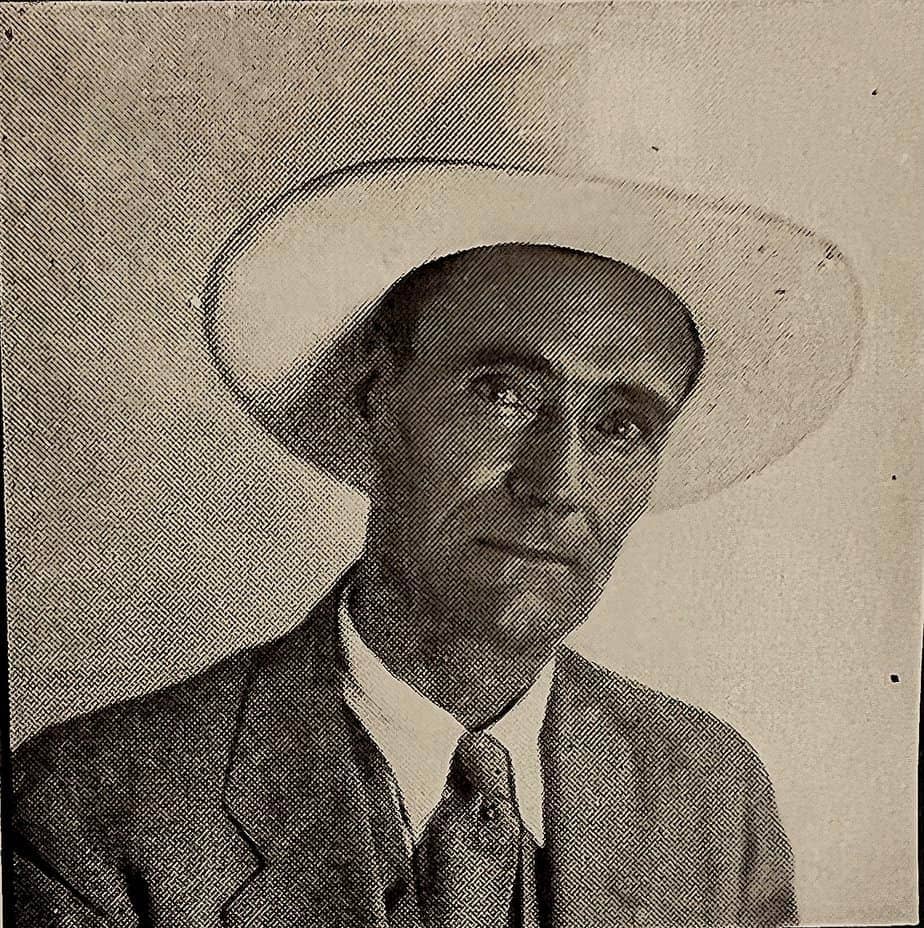
Otto Gray and His Oklahoma Cowboys band performed their last show on the road in 1936. Otto was then 52 years old and Florence was 48. After ten years of constant touring it was a relief to say goodbye to show business and return to their ranch near Stillwater, Oklahoma. As Otto explained, “I just got tired of traveling.”
Otto Gray wore many professional hats in his life, but in his heart he was always a rancher. Ranching is what he would return to in Oklahoma.

Otto Gray and His Oklahoma Cowboy band performed their last show on the road in 1936. Otto was then 52 years old and Florence was 48. After ten years of constant touring it was a relief to say goodbye to show business and return to their ranch near Stillwater, Oklahoma. As Otto explained, “I just got tired of traveling.”
Otto Gray wore many professional hats in his life, but in his heart he was always a rancher. Ranching is what he would return to in Oklahoma.
A few years after Florence died in 1952, Otto remarried. At first the couple resided at his home in Stillwater, but in time moved to his wife’s hometown in Arkansas. He died there in 1967.
Somewhere along the line Gray became fascinated by miniature livestock. Upon his return to his ranch, in addition to raising Palomino horses, he focused on miniature horses and cattle, and in particular developed his own breed of “midget” cattle. Why “midget” cattle? Perhaps Gray never lost his thinking as a showman and was always looking for a novelty to catch the public’s attention.
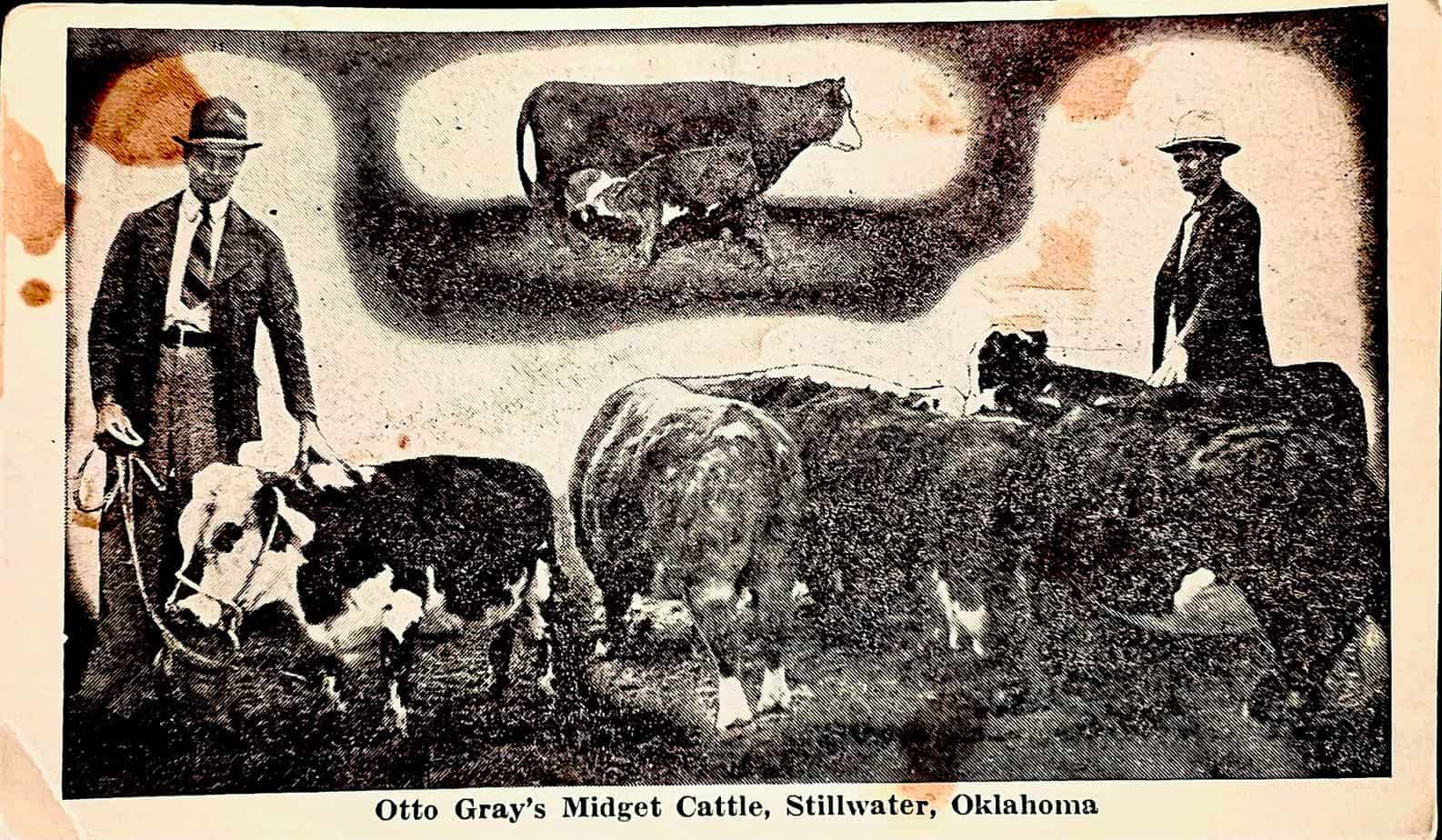
THE MAN ON THE RIGHT LOOKS LIKE OTTO GRAY. THE MAN IN THE FEDORA IS PROBABLY HIS RANCH MANAGER.
FLORENCE “MOMMIE” GRAY
Known to her many fans only as “Mommie”, Florence Gray brought a stylish elegance to Otto Gray and his Oklahoma Cowboys, wearing her custom-designed Western outfits. Her singing was popular with fans.
In the band she always added a grounding touch to a bunch of unpredictable, rowdy men. In her many publicity photos with the band she never smiles, yet she always looks mildly bemused, as if to say: “Can you believe this?”
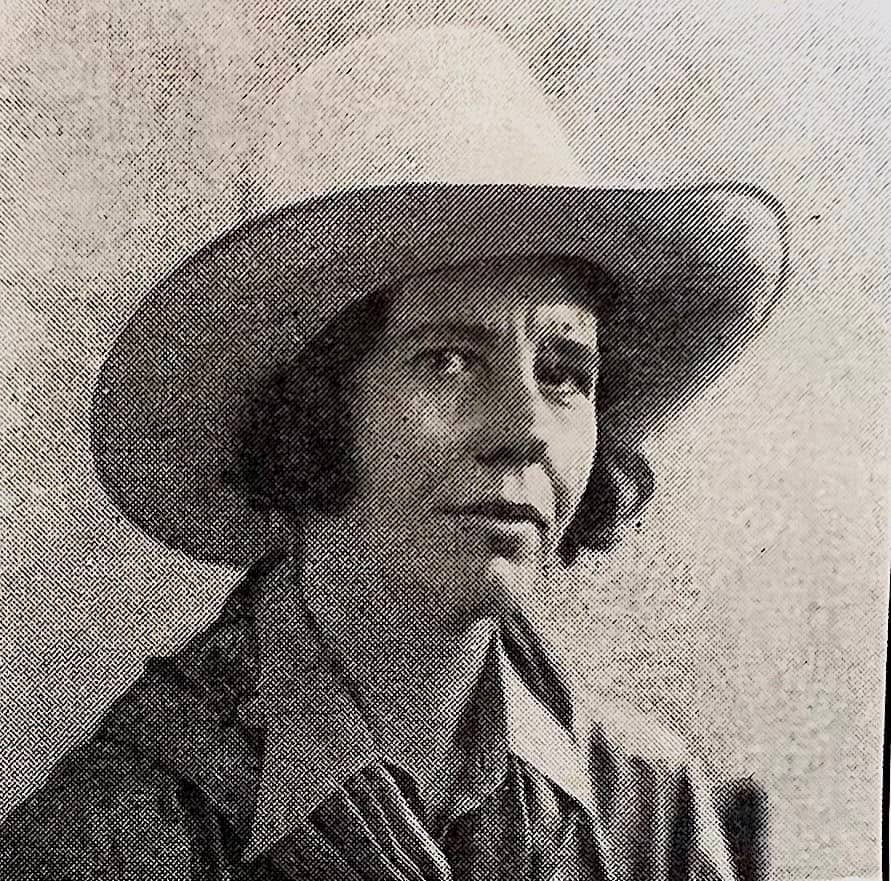

Known to her many fans only as “Mommie”, Florence Gray brought a stylish elegance to Otto Gray and his Oklahoma Cowboys, wearing her custom-designed Western outfits. Her singing was popular with fans.
In the band she always added a grounding touch to a bunch of unpredictable, rowdy men. In her many publicity photos with the band she never smiles, yet she always looks mildly bemused, as if to say: “Can you believe this?”
A life of constantly traveling in the 1920s and 1930s, driving over poor roads from engagement to engagement was a difficult lifestyle, especially for a woman. But the ranching life Florence had been born into was a hard one too. She knew that following her husband on the entertainment trail was the only way to ensure that her family had some real money. Plus, even back in the early days of performing her roping tricks for the public it was clear that Florence enjoyed entertaining
After returning to Stillwater in 1936, Florence became a housewife and gardener. She died in 1952.
OWEN GRAY

Owen Gray was the tragic member of the family.
The only child of Otto and Florence Gray, he was handsome and talented as an entertainer. Standing six feet four before putting on the boots, women found him attractive.
He began life on the road in his father’s band at age eighteen as a singer, musician, and skit comedian—he would transform himself into “Zeb—the Uke Buster”. For the next decade Owen only knew the excitement of life as a performer. Then it was suddenly over. The Vaudevillian-style entertainment world he had lived in was fading.

Owen Gray was the tragic member of the family.
The only child of Otto and Florence Gray, he was handsome and talented as an entertainer. Standing six feet four before putting on the boots, women found him attractive.
He began life on the road in his father’s band at age eighteen as a singer, musician, and skit comedian—he would transform himself into “Zeb—the Uke Buster”. For the next decade Owen only knew the excitement of life as a performer. Then it was suddenly over. The Vaudevillian-style entertainment world he had lived in was fading.
Owen would never find a substitute for Otto Gray and His Oklahoma Cowboys. He married, but soon divorced. He joined the army during World War II, but it wasn’t a career. He had both too much time on his hands and too easy access to alcohol. He died in 1947, at the age of thirty-nine.
BILLY McGINTY
As for Billy McGinty, he would indeed become postmaster for Ripley, Oklahoma.
But there would always be more to Billy’s story.
Maybe Billy wouldn’t hear the warm audience applause night after night as did his buddy Otto Gray, but he continued to earn the respect and the amazement of his friends and fellow Oklahomans throughout his long life.
In that life McGinty had hobnobbed with Buffalo Bill, Oklahoma outlaws, and Teddy Roosevelt—as well as with a thousand cowboys.
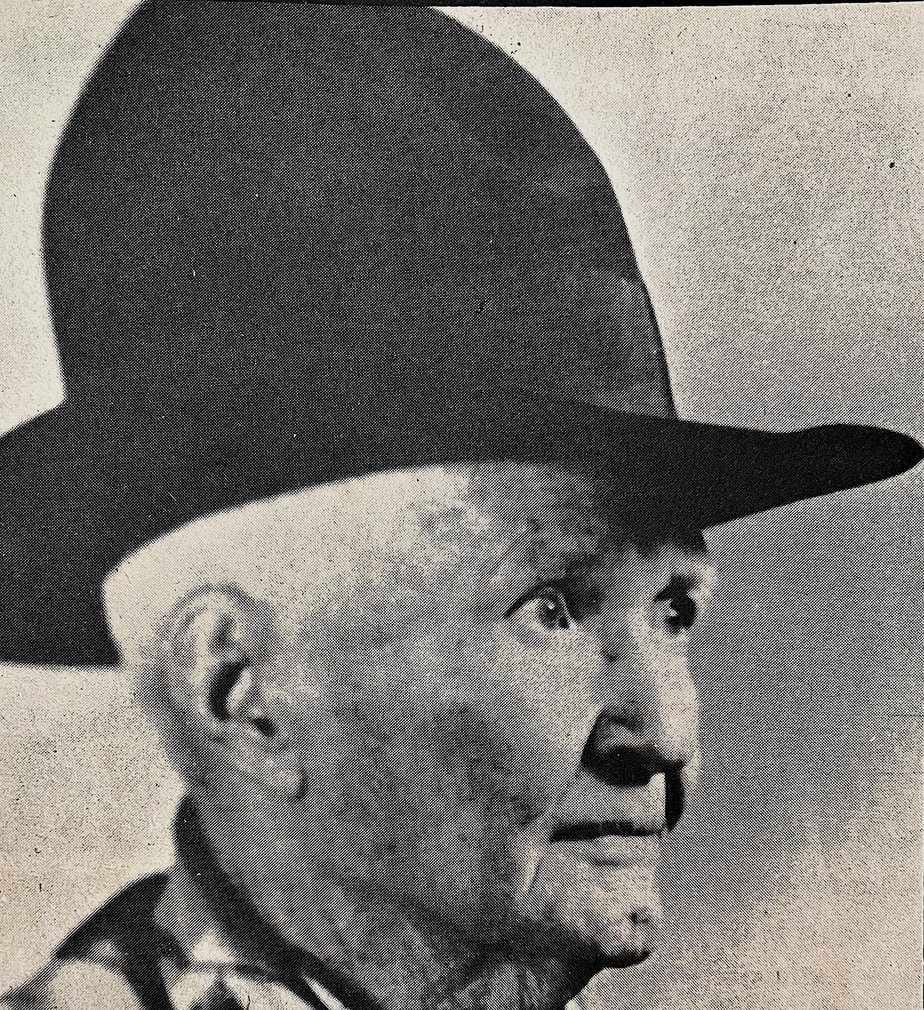
As for Billy McGinty, he would indeed become postmaster for Ripley, Oklahoma.
But there would always be more to Billy’s story.
Maybe Billy wouldn’t hear the warm audience applause night after night as did his buddy Otto Gray, but he continued to earn the respect and the amazement of his friends and fellow Oklahomans throughout his long life.

In that life McGinty had hobnobbed with Buffalo Bill, Oklahoma outlaws, and Teddy Roosevelt—as well as with a thousand cowboys.
In later years he become president of the National Rough Riders Association, drove a school bus, gave interviews to western writers, and wrote a memoir of his early life that would eventually be published by the University of Oklahoma in 2008.
He often visited his lifelong friend, Otto Gray.
He continued to ride his horses and disregarded people who said he was too old to ride.
In 1961, he was ninety years old when he died.
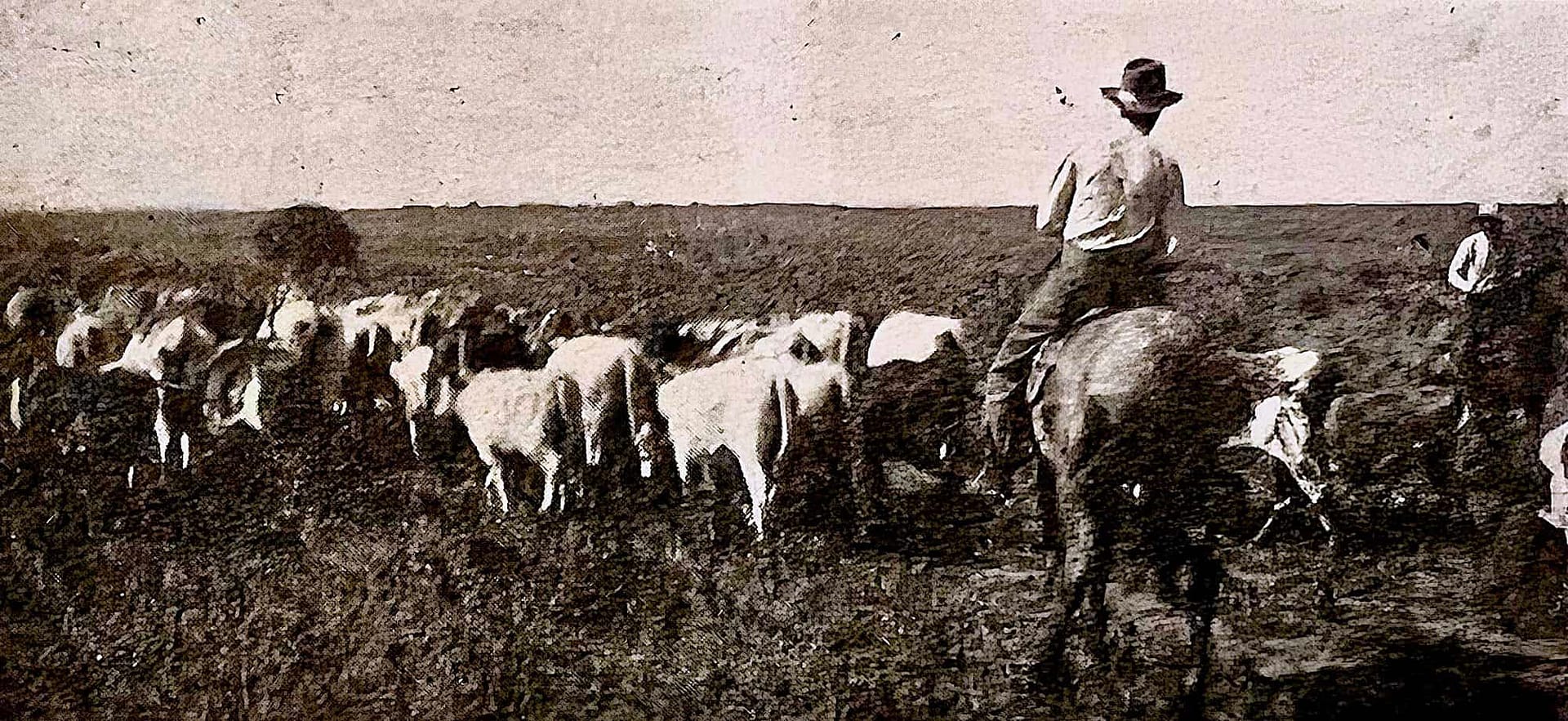
OTTO GRAY WORKING CATTLE AT HIS OKLAHOMA RANCH
Note: All records, postcards, and other ephemera from the Bowman collection.

